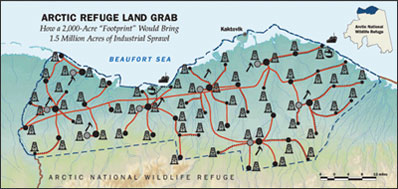|
How
a 2,000 Acre "Footprint" Would Bring 1.5 Million
Acres of Industrial Sprawl
To view a full size map and complete explanation,
please click on the map below(pdf)

If we don't do more to save the outdoors, there won't be anything left to save. Join the Sierra Club
Fast Facts
Established in 1960, the Arctic National Wildlife
Refuge is the largest and most northerly of the United States'
500 wildlife refuges. Spanning 19 million acres -- an area
roughly the size of South Carolina -- it includes 18 major
rivers flowing through landscapes that range from spruce-covered
valleys to arctic tundra.
The rugged Brooks Range, which runs along an east-west axis,
rises abruptly from the flat, tundra-covered plain to heights
of 9,000 feet above sea level.
Nestled between the high glaciers of the Brooks Range and
the lagoons and ice floes of the Beaufort Sea, the refuge's
wind-swept coastal plain is often likened to Africa's Serengeti
because of its abundant wildlife. This 1.5-million-acre expanse
-- considered by scientists the biological heart of the Refuge
-- is the also the land most sought after for drilling by
oil companies.
During the brief Arctic summer, millions of birds flock to
the coastal plain to nest and raise their young or to feed
and build up fat reserves for their next migration. Tundra
swans, pintail ducks, Arctic loons and snowy owls are among
the 180 species that have been spotted on the refuge.
The refuge is one of the few ecosystems that's home to all
three North American bear species. Polar bears and grizzlies
roam the coastal plain; black bears inhabit the broad valleys
south of the Brooks Range.
At least five species of marine mammals live in or near the
Beaufort Sea along the coastal plain's northern edge. These
include spotted seals, ringed seals, bearded seals, beluga
whales and endangered bowhead whales.
Due to the extreme cold, short growing season and nutrient-poor
soils, Arctic vegetation is extremely fragile. Plant communities
scarred by bulldozer tracks, oil spills and other human activities
can take decades to recover.
Despite its remote and pristine nature, the Arctic Refuge
and other Alaska ecosystems are already feeling the effects
of global climate change. If pack ice and permafrost continue
to melt, as many scientists expect, wildlife in the arctic
could suffer from a loss of plants and other food sources.
|









